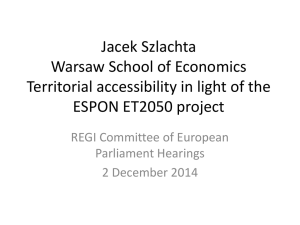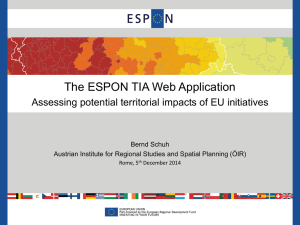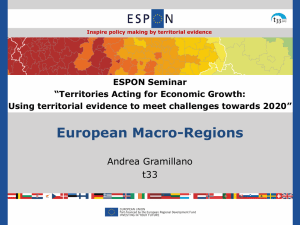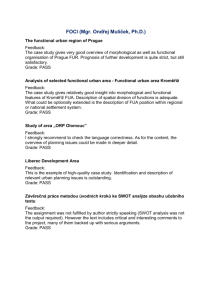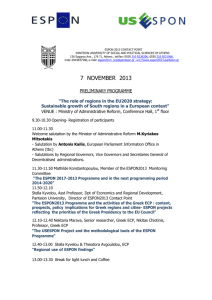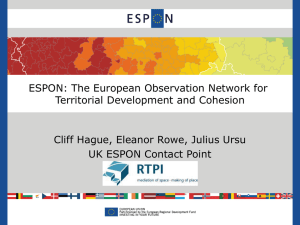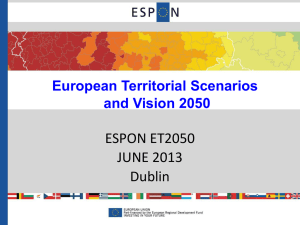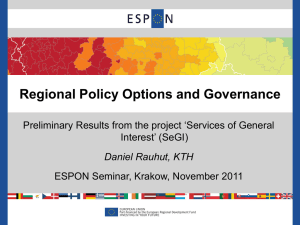Specific Objective 1
advertisement
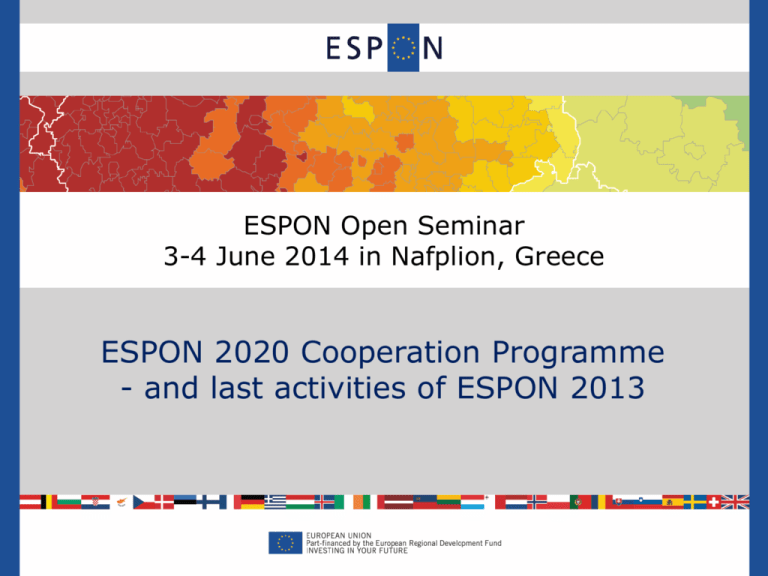
ESPON Open Seminar 3-4 June 2014 in Nafplion, Greece ESPON 2020 Cooperation Programme - and last activities of ESPON 2013 Structure of Presentation • Last activities of the ESPON 2013 Programme • Content envisaged by the ESPON 2020 Programme • Administrative set-up, procedures and budget 20142020 • Timetable for starting the ESPON 2020 activities ESPON 2013 Programme delivery 66 projects following Calls for Proposals: • 25 Applied Research projects (policy driven themes) • 23 Targeted Analyses (defined by stakeholder demand) • 10 Scientific Platform and Tools • 8 Transnational Networking Activities − 9 projects still have to deliver final results 16 MA led projects all contracted as services − 5 projects still ongoing including several actions Budget implementation status: • All funds allocated, de-commitment of funds avoided in 2013, however speed shall continue in 2014 New results until end 2014 Priority I/Applied Research projects: • Territorial Vision and Scenarios 2050, Poverty and Social Exclusion, Small and Medium sized Towns, European Neighbourhood, Economic Crisis and Regional Resilience Priority II/Targeted Analyses: • All delivered Priority III/ Scientific Platform and Tools: • EU Territorial Monitoring System, ESPON Atlas, ESPON Database Priority IV/TNA - capitalisation by ECP network: • ESPON on the Road ESPON 2013 events in autumn 2014 Seminars and workshops: • Workshop on Scenario Building primo September 2014 • Workshop on Green Economy ultimo September 2014 • Workshops at Open Days 6-9 October 2014 in Bruxelles • Joint ETC Programme Workshop on 7 October 2014 • ESPON/EC Workshop on 8 October 2014 • Final Communication event on 10 October 2014 • Workshop on Functional Urban Regions in November 2014 • ESPON seminar on 4-5 December 2014 in Rome ESPON publications in 2014 ESPON publications: • Nafplion Seminar Report • Territorial Vision and Scenarios report • ESPON Synthesis Report III • European Territorial Monitoring Report and Booklet • ESPON Atlas • ESPON 2013 Programme Results Compilation + CD • 3 more ESPON Territorial Observations • 2-3 more ESPON Evidence Briefs • ESPON Scientific Report 3 Structure of Presentation • Last activities of the ESPON 2013 Programme • Content envisaged by the ESPON 2020 Programme • Administrative set-up, procedures and Budget 20142020 • Timetable for starting the ESPON 2020 activities Renewal, refocus and upgrade of ESPON Key messages from policy arena and evaluations: − Improve the transfer of European territorial evidence − Offer more policy relevant analyses upon demand, also to ESIF programmes − Ensure effective outreach and more users − Ensure rapid deliveries to ongoing policy processes − Improve validation of scientific quality and data comparability − Enhance the in-house capacity related to science, knowledge transfer and communication − Lower the administrative burden − Apply leaner administrative procedures and renewed set up − Use public procurement, calls for tender and service contracts only Context in EC Legal Framework European Territorial Cooperation Regulation 1299/2013, Art. 2, litra (3d) calls for reinforcing the effectiveness of cohesion policy by promoting: “analyses of development trends in relation to the aims of territorial cohesion, including territorial aspects of economic and social cohesion, and harmonious development of the European territory through studies, data collection and other measures”. In addition, the ETC Regulation requests that interregional cooperation support the: “strengthening the evidence base in order to reinforce the effectiveness of cohesion policy and the achievement of the thematic objectives through the analysis of development trends.” Thematic Objective 11 selected: “Institutional capacity building & efficient public administrations”. Target Groups Primary target groups − European policymakers (Cohesion Policy, sectoral and thematic policies and programmes). − National policymakers and practitioners (responsible for territorial cohesion, ETC programmes, macro-regional strategies and Cohesion Policy implementation). − Authorities implementing ESI funded programmes and preparing periodical reporting. − Regional and local policymakers and practitioners involved in territorial development and planning, cooperation in larger territories. Secondary target groups (important receivers and users of territorial evidence) − Organisations promoting different regional/urban interests at EU level. − University academics (researchers and students). − The private sector and wider European audiences. Mission and 5 Specific Objectives Mission statement “ESPON 2020 shall continue the consolidation of a European Territorial Observatory Network and grow the provision and policy use of panEuropean, comparable, systematic and reliable territorial evidence”. 5 Specific Objectives − Specific Objective 1: Continued production of territorial evidence. − Specific Objective 2: Upgraded knowledge transfer and analytical user support. − Specific Objective 3: Improved territorial observation and tools for territorial analyses. − Specific Objective 4: Wider outreach and uptake of territorial evidence. − Specific Objective 5: Leaner, effective and efficient implementation provisions and proficient programme assistance. Priority Axes Two Priority Axes Priority Axis 1: Territorial Evidence, Transfer, Observation, Tools and Outreach (implemented by the Single Beneficiary – the ESPON EGTC) Priority Axis 2: Technical Assistance (TA) (implemented by the ESPON Managing Authority) Actions and Activities (1) Specific Objective 1: Continued Production of Territorial Evidence Through Applied Research and Analyses. • Cross-thematic and thematic on territorial structures and trends • Prospective visions and scenarios • Territorial impact studies of EU policies Specific Objective 2: Upgraded Knowledge Transfer and Use of Analytical User Support. • Targeted Analyses defined by stakeholders at national, regional and local level (expression of interest) • Territorial evidence support to ETC, other ESIF programmes and macro-regions (interest driven) • Short territorial policy briefs/working papers, fast and timely (upon demand) Actions and Activities (2) Specific Objective 3: Improved Territorial Observation and Tools for Territorial Analyses. • ESPON Database focusing on data update and user-friendliness. • European territorial observation and monitoring system with custom-made macro-regional and transnational systems (upon demand). • European monitoring reports for policy development. • A reviewed ESPON Toolbox, fine-tuning and promotion of tools. • User support related to tools (hotline, TIA, etc.) Actions and Activities (3) Specific Objective 4: Wider Outreach and Uptake of Territorial Evidence. • Events at European level (conferences, seminars, workshops, training sessions etc.) • Events at transnational and national level in cooperation with national ESPON Contact Points • Active participation at events at European, transnational and national level. • Publication of thematic and synthetic results from applied research and analyses as well as related to tools and scientific progress. • Publication of short easy-understandable reports on themes of particular political interest. • Translated material targeting regional and local policy makers and practitioners. • Web-based communication efforts, including use of social media, ‘apps’, e-learning, interactive e-books, etc. Structure of Presentation • Last activities of the ESPON 2013 Programme • Content envisaged by the ESPON 2020 Programme • Administrative set-up, procedures and budget 20142020 • Timetable for starting the ESPON 2020 activities Administrative set-up of ESPON 2020 Programme Bodies: • Monitoring Committee • Managing Authority • Certifying Authority • Audit Authority • Functions of Joint Secretariat assumed by the MA Single Beneficiary: • ESPON EGTC • Luxembourg and 3 Belgian Regions as members ESPON Contact Point Network: • Cooperating on outreach activities at transnational and national level Procedures of ESPON 2020 − Specific Objective 5: Leaner, effective and efficient implementation provisions and proficient programme assistance. • Service contracts only • No progress reporting needed from projects • National first and second level financial control in one country only, Luxembourg • Only one beneficiary to manage • Easier administrative flow for MA Preliminary Budget • • • • • ERDF contribution 41.377 mio. Euro EU Member States contribution 7.3 mio. Euro Partner State contribution 1.75 mio. Euro Additional contribution Luxembourg around 3.5 mio. Euro Total of around 53.8 mio. Euro for 2014-2020 BUDGET ESPON 2013 Priority Axis 1 Content activities by ESPON EGTC 48,965,000 Priority Axis 2 Technical Assistance by Managing Authority 4.831,000 TOTAL BUDGET 53,796,000 Structure of Presentation • Last activities of the ESPON 2013 Programme • Content envisaged by the ESPON 2020 Programme • Administrative set-up, procedures and budget 20142020 • Timetable for starting the ESPON 2020 activities Envisaged Timetable • June 2014: Submission of the proposal for the ESPON 2020 • • • • • • Cooperation Programme October 2014: Formal establishment of the ESPON EGTC November 2014: European Commission approval 2-3 December 2014: First ESPON 2020 Monitoring Committee meeting inviting the ESPON EGTC for a Operation Proposal (OP) January 2015: ESPON EGTC submission of OP April 2015: MC decision and contracting of the ESPON EGTC May 2015: First calls for tender and interest. ESPON 2020 Programme Thank you for your attention Inspire policy making by territorial evidence www.espon.eu
